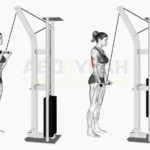Seated Leg Extension: Exercise Overview
The seated leg extension is a targeted isolation exercise designed to strengthen the quadriceps, the large muscles on the front of the thighs. This movement focuses solely on the quads, making it an effective choice for those aiming to enhance leg aesthetics or isolate the quadriceps for specific development goals. However, the leg extension can place significant stress on the knees, so individuals with pre-existing knee issues may benefit from opting for compound movements like squats or lunges instead (Escamilla et al., 2008). Ideal for aesthetic-focused training, the seated leg extension can be incorporated into leg workouts, lower-body routines, or full-body programs to support balanced leg development (Schoenfeld, 2010).
How to Perform the Seated Leg Extension
- Choose an appropriate weight on the machine’s weight stack and secure the pin.
- Adjust the seat so your knees align directly with the machine’s pivot point (axis of rotation).
- Sit on the machine, placing your shins behind the ankle pad, ensuring it rests comfortably just above your ankles.
- Grip the handles for stability, take a deep breath, and extend your legs by contracting your quadriceps until your knees are fully straightened.
- Exhale at the top of the movement, pausing briefly to maximize quad engagement.
- Slowly lower your legs back to the starting position with control, keeping tension in the quadriceps.
- Repeat for the desired number of repetitions.
Tips for Optimal Performance
- Align Knees Properly: Ensure the machine’s axis of rotation matches your knee joint to minimize stress and reduce injury risk (Escamilla et al., 2008). Misalignment can strain the knee, so adjust the seat carefully.
- Avoid Heavy Weights: Use moderate resistance to prevent excessive stress on the knees, as the lack of hamstring co-contraction in this isolation movement increases joint strain (McGill, 2010).
- Enhance Muscle Connection: Point your toes slightly outward to increase quad activation and improve the mind-muscle connection (Schoenfeld, 2016).
- Control the Movement: Perform both the lifting and lowering phases slowly to maximize time under tension and avoid momentum, which enhances muscle growth.
- Breathe Correctly: Exhale as you extend your legs and inhale as you lower them to support controlled movement and muscle oxygenation.
- Maintain Proper Posture: Keep your back flat against the seat and avoid lifting your hips to ensure the quads remain the primary focus.
Targeting quads with leg extensions? Dive into our Ultimate Guide to Muscle Groups for a complete leg workout.







